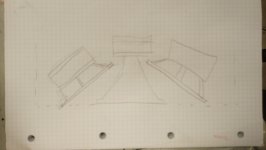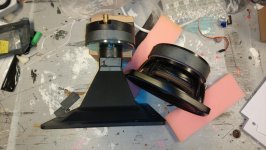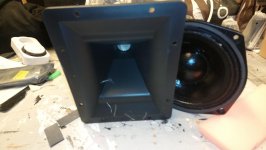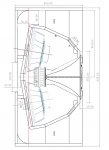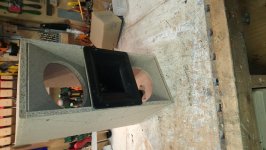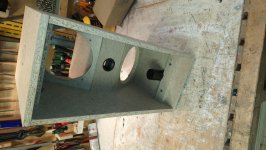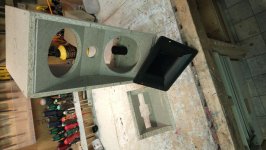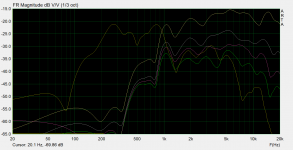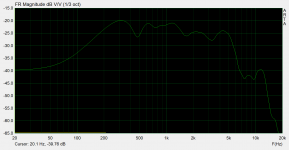To make a small PA top Even smallere Im thinking about alternative ways of arranging the drivers.
I'll be using 2pcs 6" mid/bass and a horn with a faceplate thats approx 20cm wide and 15cm high.
Crossover around 2khz
How bad would My attached idea be?
Kind regards TroelsM
I'll be using 2pcs 6" mid/bass and a horn with a faceplate thats approx 20cm wide and 15cm high.
Crossover around 2khz
How bad would My attached idea be?
Kind regards TroelsM
Attachments
This reminds me of slot loading. for high frequency extension I think you would want to minimise the volume of the cavity formed in front of the woofers. I.E as ErnieM says keep the gaps to a minimum.
See from #2631 here:
What is the ideal directivity pattern for stereo speakers?
See from #2631 here:
What is the ideal directivity pattern for stereo speakers?
Thank you for the input.
It may be a stupid idea to save a few cm in build-size, but it would be a novel look.
I tried to simulate some of in Hornresp, but I guess it wont be accurate.
HR suggests that it may actually boost output a little, but the response will not be very linear.
I have a few things to do before I can test this, but I see a small test-cap in my future ;-)
Kind regards TroelsM
It may be a stupid idea to save a few cm in build-size, but it would be a novel look.
I tried to simulate some of in Hornresp, but I guess it wont be accurate.
HR suggests that it may actually boost output a little, but the response will not be very linear.
I have a few things to do before I can test this, but I see a small test-cap in my future ;-)
Kind regards TroelsM
Meyer seem to think it's possible:
ULTRA-X | Meyer Sound
But they've used a large-format HF driver.
The RCF HDL6 is also worth a look - that uses a small-format HF unit.
Chris
ULTRA-X | Meyer Sound
But they've used a large-format HF driver.
The RCF HDL6 is also worth a look - that uses a small-format HF unit.
Chris
Hi, this arrangement will provide a boost in the upper range of the woofers, but also provide cancellations that will lower the upper cutoff, as the mass of air in front of the drivers will act as a band pass filter (consider the sound wave leaving the driver and reaching the start of the horn and going back towards the mouth summing with the original wave, when the waves are half wavelength apart they will be totally out of phase and cancel each other, so you can expect cancellations from a frequency that has a wavelength four times the distance from throat of the horn to s2, where the ofset driver is. For 8.5 cm distance cancellations will start around 1khz where wavelength is around 34 cm)
.
Usually with 6 inch drivers you would use a fairly high crossover point and a small compression driver, but this design could force you to cross at 1kHz or lower, demanding a bigger comp and horn.
To avoid this you should reduce as much as possible the volume of air and the length between the start of the horn and the mid of the driver, if you look at offset horn in hornresp this would mean reducing s1, s2 and L12 as much as possible.
.
Usually with 6 inch drivers you would use a fairly high crossover point and a small compression driver, but this design could force you to cross at 1kHz or lower, demanding a bigger comp and horn.
To avoid this you should reduce as much as possible the volume of air and the length between the start of the horn and the mid of the driver, if you look at offset horn in hornresp this would mean reducing s1, s2 and L12 as much as possible.
I got a few (very) rough measurements. Outdoor, 120cm above ground. 3meter from speaker to mic.
"orange/brown-ish" is the 2 mid/woofs in series.
The others are tweeter at different angles up to almost 90deg There is a 6.8uF in series to protect. Levels are NOT the same for all sweeps.
Im very pleased with the tweeter and horn. For the money, it looks fine to me.
As expected there is a dip above 1Khz due to the short horn. Im still not sure what the 500Hz is.
Most surprising part is that the speaker actually makes nice music with just the series-cap. There is little bottom, but thats expected as the 6" are NOT woofers.
I'll try to recreate some of the artifacts in a HR-sim, and if time allows I'll try to move the mid/woofs to mimimize the volume in front of them
Any ideas?
Kind regards
"orange/brown-ish" is the 2 mid/woofs in series.
The others are tweeter at different angles up to almost 90deg There is a 6.8uF in series to protect. Levels are NOT the same for all sweeps.
Im very pleased with the tweeter and horn. For the money, it looks fine to me.
As expected there is a dip above 1Khz due to the short horn. Im still not sure what the 500Hz is.
Most surprising part is that the speaker actually makes nice music with just the series-cap. There is little bottom, but thats expected as the 6" are NOT woofers.
I'll try to recreate some of the artifacts in a HR-sim, and if time allows I'll try to move the mid/woofs to mimimize the volume in front of them
Any ideas?
Kind regards
Attachments
Last edited:
I got a few (very) rough measurements. Outdoor, 120cm above ground. 3meter from speaker to mic.
Have you tried time gating your measurements to eliminate reflections?
Loudspeaker measurements
Also as your outdoors you could perform ground plane measurements:
Measure speaker frequency response - Different techniques
I'm debating with my self, if I want to use 1 or 2 mid/bass-drivers.
I got 8 pcs in total, so for once thats not a problem, - but other factors are:
Any comments?
Kind regards TroelsM
I got 8 pcs in total, so for once thats not a problem, - but other factors are:
- 2 drivers means a bigger and heavier cabinet ( these are SOLID drivers)
- One driver is listed to take 200W ( 2" VC), so we have a potential massive heat-buildup in a small volume
- will 2 drivers have a benefit over a single with regards to directivity/beam control?
Any comments?
Kind regards TroelsM
Well, I use a pair of midbass drivers (2x10"s) below a 90x40 HF horn. The driver arrangement means the vertical directivity is maintained below the crossover frequency, which is handy.
There are ways to remove heat from a cabinet - there's not much harm in putting a bass reflex port in there. Tune it fairly low and you'll avoid phase shifts near the LF crossover frequency.
Chris
There are ways to remove heat from a cabinet - there's not much harm in putting a bass reflex port in there. Tune it fairly low and you'll avoid phase shifts near the LF crossover frequency.
Chris
The two drivers are 3dB more efficient when within 1/4 wave length of each other due to the larger radiating surface, reducing heat build up. Also long term power handling will be increased even in a sealed box as the driver has a lower thermal resistance to ambient than the box walls. I would second Chris's recommendation to port the box though as it stops hot air getting trapped in the box. I would tune the box to the end of the desired pass band (60 - 80Hz) to reduce distortion and reduce the port size compared to a low tuned port though. (unless of course you want to run these tops without subs whereupon a lower tuned port would be more appropriate.
If you want to use ports for cooling, Eminence advises in this pdf page 7+10 to use 2 ports, 1 above and 1 below the driver(s); then you start to get some circulation as warm air is a bit lighter then cold air, and will be pushed out a bit more then the cooler air at the bottom port.
With 1 port you will only get cool air in when the port is very short. (less air in the port then moved by the driver)
An aluminum plate as top of a cabinet can provide (extra) cooling for sealed and ported boxes.
A MTM will have more vertical directivity then a TMM.
And even though I still have not used MTM's for PA, it seems like a good idea to me to have half of the mids above the tweeter, so they reach the back of the crowd when you set the speaker up with the tweeters just above head height and a bit tilted forwards/pointed down.
Probably next week my tiny vertical pvc pipes with 4x 3.3" visaton frs8m and dayton mini planar (middle in front of mid drivers) crossed at 5kHz and some sealed 12" subs are going to be used for a restaurant gig by some musician friends of mine. Replacing the Stagepass 300 they normally use there.
ATM I'm playing with some Alphalites 6A's 6.5" and planar tweeters in MTM and 2.8kHz seems to be fine. Planer/amt/ribbons are lines; very narrow vertical off axis and superb/wide horizontal off axis response. Great details without listening fatigue.
You can use 6" at least up to 2kHz but will have to look at the of axis response.
To bad Faital pro published off axis responses don't seem to match reality; 10dB down@ 45 degrees off axis instead of the published 5dB at 3-4kHz;
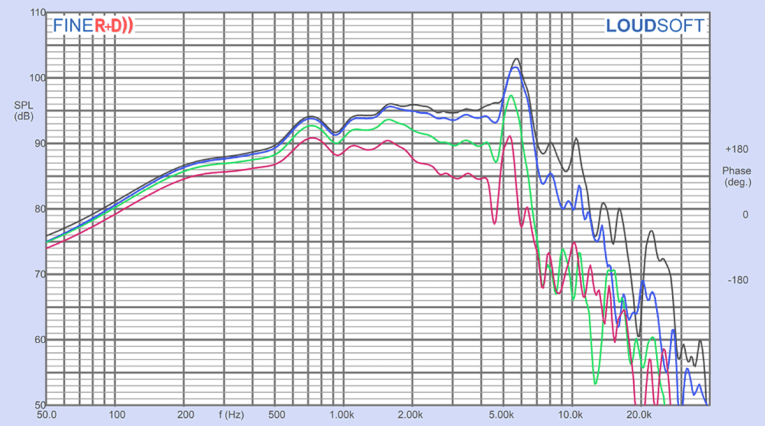
Test Bench: The New Faital Pro 6" 6PR160 Midwoofer/Midrange | audioXpress

FaitalPRO | LF Loudspeakers | 6PR160
With 1 port you will only get cool air in when the port is very short. (less air in the port then moved by the driver)
An aluminum plate as top of a cabinet can provide (extra) cooling for sealed and ported boxes.
A MTM will have more vertical directivity then a TMM.
And even though I still have not used MTM's for PA, it seems like a good idea to me to have half of the mids above the tweeter, so they reach the back of the crowd when you set the speaker up with the tweeters just above head height and a bit tilted forwards/pointed down.
Probably next week my tiny vertical pvc pipes with 4x 3.3" visaton frs8m and dayton mini planar (middle in front of mid drivers) crossed at 5kHz and some sealed 12" subs are going to be used for a restaurant gig by some musician friends of mine. Replacing the Stagepass 300 they normally use there.
ATM I'm playing with some Alphalites 6A's 6.5" and planar tweeters in MTM and 2.8kHz seems to be fine. Planer/amt/ribbons are lines; very narrow vertical off axis and superb/wide horizontal off axis response. Great details without listening fatigue.
You can use 6" at least up to 2kHz but will have to look at the of axis response.
To bad Faital pro published off axis responses don't seem to match reality; 10dB down@ 45 degrees off axis instead of the published 5dB at 3-4kHz;

Test Bench: The New Faital Pro 6" 6PR160 Midwoofer/Midrange | audioXpress

FaitalPRO | LF Loudspeakers | 6PR160
Got think about the problem with the air-volume in front of the cone and ways of dealing with it.
The design I have now, have very little volume and "short horn lenght", but would it still be beneficial to add a sort of "phaseplug" in front of the cone to minimize volume?
- Could a phaseplug actually boost output a little or have other interesting side-eftects?
It is very likely totally unnecessary, but I haven't done a phase-plug before and off cause curiosity peaks in ;-)
Kind regards TroelsmM
The design I have now, have very little volume and "short horn lenght", but would it still be beneficial to add a sort of "phaseplug" in front of the cone to minimize volume?
- Could a phaseplug actually boost output a little or have other interesting side-eftects?
It is very likely totally unnecessary, but I haven't done a phase-plug before and off cause curiosity peaks in ;-)
Kind regards TroelsmM
Last edited:
- Status
- This old topic is closed. If you want to reopen this topic, contact a moderator using the "Report Post" button.
- Home
- Live Sound
- PA Systems
- MTM configs for small PA top
